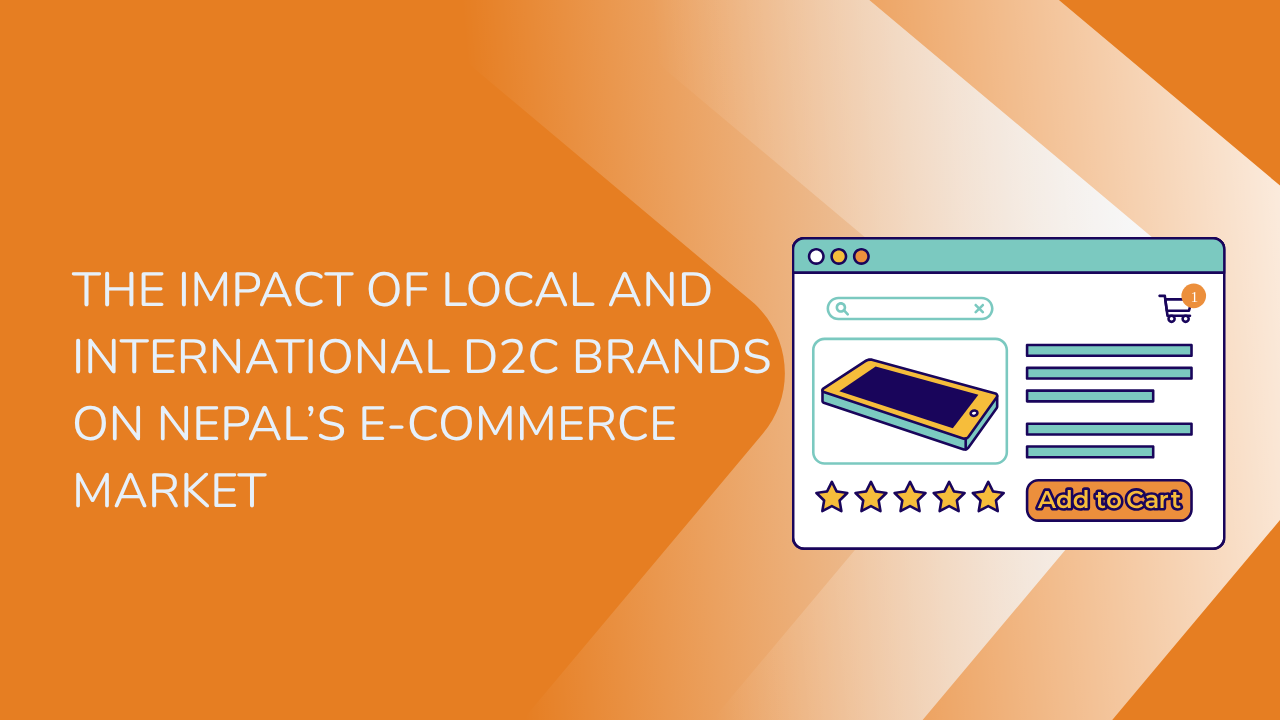Share this Article
Launching a Direct-to-Consumer (D2C) brand in Nepal presents an exciting opportunity for entrepreneurs, especially with the increasing penetration of the internet and mobile devices. The D2C model allows businesses to engage directly with consumers, cut out intermediaries, and offer a personalized experience. For entrepreneurs in Nepal, this guide provides a practical, step-by-step approach to starting a D2C brand from the initial concept to its execution.
Step 1: Identifying a Niche Market
The foundation of any successful D2C brand lies in identifying a niche market. You need to focus on a specific segment that is underserved or has untapped potential. Conducting thorough market research will help you understand the demands of your target audience. Here are some strategies to find your niche:
- Market Research: Begin by researching the market to identify existing gaps. This could involve looking at consumer needs in various sectors such as health, lifestyle, technology, or local products that aren’t being effectively met. Also, investigate competitor brands to see if there is room for improvement.
- Consumer Preferences: Consumers in Nepal are becoming more tech-savvy and are looking for convenience, quality, and personalized service. Understanding consumer behavior and preferences will help in selecting the right product to sell.
- Local Trends: Pay attention to trends in Nepal, such as rising disposable income, increased internet usage, and the demand for eco-friendly products. These trends can guide your product development and marketing strategy.
Step 2: Creating a Solid Business Plan
After determining your market niche, the next step is to develop a business plan. A business plan acts as a blueprint for your brand, outlining how the business will operate, its goals, and its strategies. Essential components of the business plan include:
- Mission and Vision: Start by defining the purpose of your brand. Why does your brand exist, and what problem does it solve for your customers? Also, set a vision for where you want your brand to go in the future.
- Target Audience: Identify who your customers are. Are you targeting the youth, working professionals, or health-conscious individuals? Defining your target audience will help you tailor your marketing strategies.
- Product Offering: Decide on the products you want to sell, making sure they meet the needs and desires of your target audience. Whether it’s eco-friendly products, fashion, or wellness, your offerings should be relevant and of high quality.
- Revenue Model: Define how your brand will make money. This includes setting a pricing strategy based on production costs, competitive prices, and profit margins.
- Budgeting and Funding: Calculate the initial cost for starting the business, including expenses like website development, product sourcing, branding, and marketing. You may need funding through savings, loans, or investors to cover these costs.
Step 3: Establishing Your Brand Identity
Your brand identity will be critical in distinguishing your business from others. A unique and recognizable brand will help attract loyal customers and enhance customer retention. Consider the following aspects of your brand identity:
- Brand Name and Logo: Choose a name that’s catchy, memorable, and easy to pronounce. Your logo should be simple yet visually representative of your brand’s values.
- Brand Values and Messaging: Establish your brand’s core values—such as quality, sustainability, and customer satisfaction—and ensure your messaging aligns with these values. Consistency in how you communicate across platforms is key.
- Packaging and Presentation: Packaging plays a vital role in the D2C model. Focus on creating packaging that stands out, represents your brand's values, and offers a seamless unboxing experience for customers. Consider eco-friendly packaging options as sustainability is a growing trend in Nepal.
- Storytelling: Every brand has a story, and telling yours effectively can resonate with your audience. Whether it's about your journey as an entrepreneur or the unique inspiration behind your products, storytelling helps build an emotional connection with your customers.
Step 4: Sourcing Products
Sourcing products is a crucial step, whether you plan to manufacture the products yourself or source them from third-party suppliers. The method you choose will influence your business's production timeline, costs, and quality control processes:
- In-house Production: If you can handle production in-house, you can have full control over product quality. This is ideal for entrepreneurs who want to create unique, handcrafted items, like local crafts, apparel, or accessories.
- Third-party Manufacturing: Many D2C brands in Nepal opt to partner with manufacturers who handle the production process. It's essential to find reliable suppliers who align with your values regarding product quality, ethics, and sustainability.
- Inventory Management: You’ll need a system to manage your stock. Consider options like keeping inventory in-house or utilizing fulfillment services that store, package, and ship products directly to customers.
Step 5: Building Your E-commerce Website
As a D2C brand, your website will be your primary sales channel. It’s essential to build a professional, user-friendly website that represents your brand and drives conversions. Here are key factors to consider:
- Choose an E-commerce Platform: Popular platforms for building an online store include Shopify, WooCommerce (for WordPress), and BigCommerce. Select the one that fits your budget and needs, and ensures scalability as your business grows.
- Website Design and User Experience: Design a website that’s visually appealing and easy to navigate. Make sure your site is optimized for mobile users since a large portion of Nepali consumers browse and shop via mobile devices.
- Payment Gateway Integration: Offering multiple payment options is crucial. Integrate reliable payment gateways like eSewa, Khalti, or credit/debit cards, so customers can complete transactions seamlessly.
- Shipping and Delivery: Be transparent about your shipping policies and delivery times. Partnering with reliable local courier services can ensure that your products reach customers in a timely manner.
Step 6: Implementing Digital Marketing Strategies
In the D2C model, digital marketing plays an essential role in building brand awareness, generating traffic, and driving sales. Here are some digital marketing strategies to help you succeed:
- Social Media Marketing: Platforms like Facebook, Instagram, and TikTok are vital for building brand awareness. Engage your audience with creative posts, paid ads, and regular updates. Use stories, reels, and videos to increase engagement.
- Influencer Marketing: Collaborating with local influencers or bloggers can expand your reach. Influencers can help showcase your products to their audience, increasing visibility and trust.
- Search Engine Optimization (SEO): Optimize your website for search engines so that it ranks higher in search results. Focus on optimizing product descriptions, blogs, and other content with relevant keywords.
- Email Marketing: Build an email list and use it to send newsletters with product updates, special offers, and informative content. Email marketing helps retain customers and increase sales over time.
- Content Marketing: Develop valuable content such as blog posts, tutorials, or product reviews. Content marketing establishes your brand as an authority in the industry and builds customer loyalty.
Step 7: Providing Exceptional Customer Service
Customer service is one of the strongest pillars of the D2C business model. Providing excellent support ensures customer satisfaction, retention, and positive word-of-mouth. Here’s how you can offer great customer service:
- Live Chat Support: Integrate live chat on your website to answer customer queries in real time.
- Email Support: Provide prompt email support for more detailed inquiries and post-purchase assistance.
- Social Media Support: Ensure timely responses to customer queries on social media platforms like Facebook and Instagram.
Step 8: Tracking and Analyzing Performance
Once your D2C brand is launched, it’s essential to monitor its performance. This allows you to make data-driven decisions and improve your business strategies. Here are some ways to track performance:
- Analytics Tools: Use tools like Google Analytics and social media insights to monitor key metrics such as website traffic, conversion rates, and customer behavior.
- Customer Feedback: Encourage customers to leave reviews and provide feedback. This can help you understand what customers like or dislike about your products and services.
- Adjust Marketing Campaigns: Use performance data to refine your marketing strategies. For example, if a particular social media post generates more engagement, consider creating similar content to maintain momentum.
Step 9: Scaling Your Brand
After successfully establishing your D2C brand, you can consider scaling your operations. Scaling involves expanding your product line, reaching new markets, and increasing your marketing efforts. However, scaling requires careful planning and resource allocation. Here are some tips:
- Product Expansion: Consider introducing new product lines or variations of existing products to meet changing customer needs.
- Entering New Markets: If you have found success in one city or region, you can explore expanding into other cities like Pokhara, Lalitpur, or Bhaktapur.
- Partnerships and Collaborations: Collaborating with other brands, influencers, or retailers can help you scale faster and reach a larger audience.
Conclusion
Starting a D2C brand in Nepal presents exciting opportunities in the rapidly growing e-commerce sector. By following this step-by-step guide—identifying a niche, building a strong brand identity, sourcing quality products, and implementing effective digital marketing strategies—you can create a successful D2C business. With dedication, transparency, and a focus on customer experience, your D2C brand can thrive in Nepal’s evolving retail landscape, offering both challenges and rewards for entrepreneurs willing to take the plunge.
Categories:
Beginner’s Guides
Tags:
5 Simple Steps







